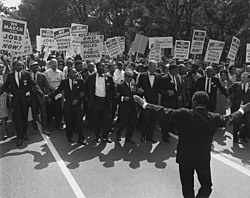BLACK SOCIAL HISTORY
American Jewish community and the Civil Rights movement
Many in the Jewish community supported the Civil Rights Movement. In fact, statistically Jews were one of the most actively involved non-black groups in the Movement. Many Jewish students worked in concert with African Americans for CORE, SCLC, and SNCC as full-time organizers and summer volunteers during the Civil Rights era. Jews made up roughly half of the white northern volunteers involved in the 1964 Mississippi Freedom Summer project and approximately half of the civil rights attorneys active in the South during the 1960s.[159]
Jewish leaders were arrested while heeding a call from Rev. Dr. Martin Luther King, Jr. in St. Augustine, Florida, in June 1964, where the largest mass arrest of rabbis in American history took place at the Monson Motor Lodge—a nationally important civil rights landmark that was demolished in 2003 so that a Hilton Hotel could be built on the site. Abraham Joshua Heschel, a writer, rabbi, and professor of theology at the Jewish Theological Seminary of America in New York, was outspoken on the subject of civil rights. He marched arm-in-arm with Dr. King in the 1965 Selma to Montgomery march. In the Mississippi civil rights workers' murders of 1964, the two white activists killed, Andrew Goodman and Michael Schwerner, were both Jewish.
Brandeis University, the only nonsectarian Jewish-sponsored college university in the world, created the Transitional Year Program (TYP) in 1968, in part response to Rev. Dr. Martin Luther King's assassination. The faculty created it to renew the University's commitment to social justice. Recognizing Brandeis as a university with a commitment to academic excellence, these faculty members created a chance to disadvantaged students to participate in an empowering educational experience.
The program began by admitting 20 black males. As it developed, two groups have been given chances. The first group consists of students whose secondary schooling experiences and/or home communities may have lacked the resources to foster adequate preparation for success at elite colleges like Brandeis. For example, their high schools do not offer AP or honors courses nor high quality laboratory experiences.
Students selected had to have excelled in the curricula offered by their schools. The second group of students includes those whose life circumstances have created formidable challenges that required focus, energy, and skills that otherwise would have been devoted to academic pursuits. Some have served as heads of their households, others have worked full-time while attending high school full-time, and others have shown leadership in other ways.
The American Jewish Committee, American Jewish Congress, and Anti-Defamation League (ADL) actively promoted civil rights.
While Jews were very active in the civil rights movement in the South, in the North, many had experienced a more strained relationship with African Americans. In communities experiencing white flight, racial rioting, and urban decay, Jewish Americans were more often the last remaining whites in the communities most affected. With Black militancy and the Black Power movements on the rise, Black Anti-Semitism increased leading to strained relations between Blacks and Jews in Northern communities. In New York City, most notably, there was a major socio-economic class difference in the perception of African Americans by Jews.[160] Jews from better educated Upper Middle Class backgrounds were often very supportive of African American civil rights activities while the Jews in poorer urban communities that became increasingly minority were often less supportive largely in part due to more negative and violent interactions between the two groups.


























































































































No comments:
Post a Comment